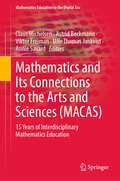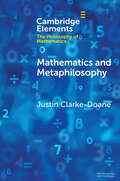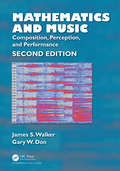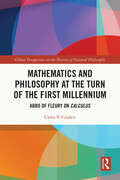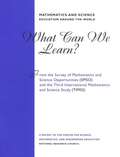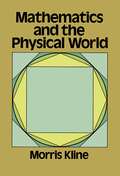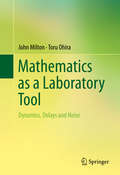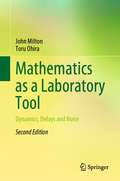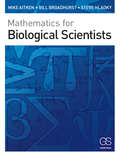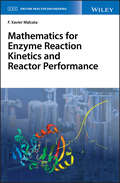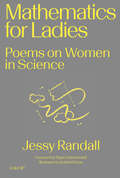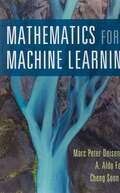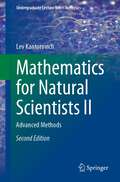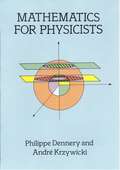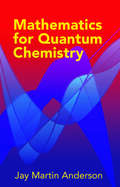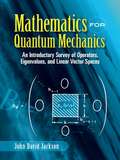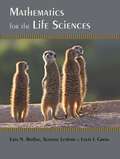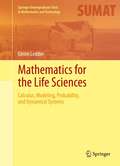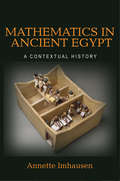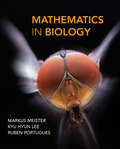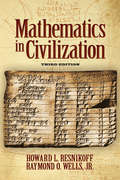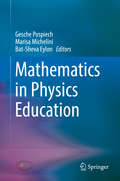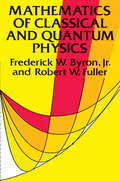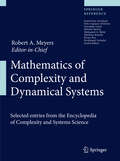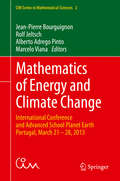- Table View
- List View
Mathematics and Its Connections to the Arts and Sciences: 15 Years of Interdisciplinary Mathematics Education (Mathematics Education in the Digital Era #19)
by Viktor Freiman Annie Savard Claus Michelsen Astrid Beckmann Uffe Thomas JankvistThis book celebrates the 15th anniversary of the bi-annual symposium series Mathematics and its Connections to the Arts and Sciences (MACAS), which was first held in 2005 following the continued collaboration of an international group of researchers from ICME Topic Study Group 21. The MACAS-conferences bring together scientists and educators who are interested in the connection between mathematics, arts and science in educational curriculum, while emphasizing on, as well as researching about, the role of mathematics. By pooling together these different approaches and viewpoints between mathematics, arts and sciences, this book reveals possible synergies and paths for collaborations. In view of the challenges of the 21st century, a modern approach to education with a focus on multi- and interdisciplinarity is more important than ever. The role of mathematics assumes a key role in this approach as it is connected to all other disciplines, such as STEM education, physics, chemistry, biology, aesthetics and language, and can serve as a bridge between them. This book discusses, amongst others, the curricular approaches to integrate mathematics and other disciplines, the importance of mathematical modelling and the interdisciplinarity ways for learning and studying of mathematics, as well as the intercultural dimensions of mathematics and mathematics in the digital era. All topics will be presented from very different perspectives and regarding very different contexts, including digitization, culture and sustainability. This unique collection will serve as a very valuable and compact source for all above mentioned scientists and educators, as well as for use in advanced teacher education courses.
Mathematics and Metaphilosophy (Elements in the Philosophy of Mathematics)
by Justin Clarke-DoaneThis Element discusses the problem of mathematical knowledge, and its broader philosophical ramifications. It argues that the challenge to explain the (defeasible) justification of our mathematical beliefs ('the justificatory challenge'), arises insofar as disagreement over axioms bottoms out in disagreement over intuitions. And it argues that the challenge to explain their reliability ('the reliability challenge'), arises to the extent that we could have easily had different beliefs. The Element shows that mathematical facts are not, in general, empirically accessible, contra Quine, and that they cannot be dispensed with, contra Field. However, it argues that they might be so plentiful that our knowledge of them is unmysterious. The Element concludes with a complementary 'pluralism' about modality, logic and normative theory, highlighting its surprising implications. Metaphysically, pluralism engenders a kind of perspectivalism and indeterminacy. Methodologically, it vindicates Carnap's pragmatism, transposed to the key of realism.
Mathematics and Music: Composition, Perception, and Performance
by James S. Walker Gary W. DonMathematics and Music: Composition, Perception, and Performance, Second Edition includes many new sections and more consistent expectations of a student’s experience. The new edition of this popular text is more accessible for students with limited musical backgrounds and only high school mathematics is required. The new edition includes more illustrations than the previous one and the added sections deal with the XronoMorph rhythm generator, musical composition, and analyzing personal performance. The text teaches the basics of reading music, explaining how various patterns in music can be described with mathematics, providing mathematical explanations for musical scales, harmony, and rhythm. The book gives students a deeper appreciation showing how music is informed by both its mathematical and aesthetic structures. Highlights of the Second Edition: Now updated for more consistent expectations of students’ backgrounds More accessible for students with limited musical backgrounds Full-color presentation Includes more thorough coverage of spectrograms for analyzing recorded music Provides a basic introduction to reading music Features new coverage of building and evaluating rhythms
Mathematics and Philosophy at the Turn of the First Millennium: Abbo of Fleury on Calculus (Global Perspectives on the History of Natural Philosophy)
by Clelia V. CrialesiAt the turn of the first millennium, scientific and philosophical knowledge was far from dormant. Arithmetic, with its diverse calculation techniques and number theory, served as a bridge to philosophy, theology, and the study of the physical world. Even something as simple as a series of multiplication tables could unlock a profound knowledge of both the divine realm and natural phenomena. Such is the case with Abbo of Fleury’s Commentary on the Calculus.Mathematics and Philosophy at the Turn of the First Millennium sheds light on Abbo’s original philosophical system anchored in two central doctrines, which serve as a compass to navigate it: the theory of unity (henology) and the theory of composition. Yet, the Commentary on the Calculus covers much more. The present study, thus, explores an eclectic range of topics – from water clocks to barleycorns, constellations to human voice, synodic month to the human lifespan, and numbers to God. Abbo’s work is an ambitious attempt to tie together the study of both the visible and invisible realms, what can be measured and what cannot, what can be quantified and what exceeds quantification.Scholars and students of the history of philosophy and mathematics will be introduced to a pivotal figure from an often overlooked era. They will be provided with fresh insights into the spread of Neopythagorean doctrines in the early Middle Ages, as they learn how these ideas were transmitted through arithmetic texts and harmonised with theology and natural philosophy. They will also get to know the medieval fraction system and calculus practices.
Mathematics and Science Education Around the World: What Can We Learn From the Survey of Mathematics and Science Opportunities (SMSO) and the Third International Mathematics and Science Study (TIMSS)?
by "SMSO to TIMSS" Writing CommitteeThe National Academies Press (NAP)--publisher for the National Academies--publishes more than 200 books a year offering the most authoritative views, definitive information, and groundbreaking recommendations on a wide range of topics in science, engineering, and health. Our books are unique in that they are authored by the nation's leading experts in every scientific field.
Mathematics and the Physical World
by Morris Kline"Kline is a first-class teacher and an able writer. . . . This is an enlarging and a brilliant book." - Scientific American"Dr. Morris Kline has succeeded brilliantly in explaining the nature of much that is basic in math, and how it is used in science." - San Francisco ChronicleSince the major branches of mathematics grew and expanded in conjunction with science, the most effective way to appreciate and understand mathematics is in terms of the study of nature. Unfortunately, the relationship of mathematics to the study of nature is neglected in dry, technique-oriented textbooks, and it has remained for Professor Morris Kline to describe the simultaneous growth of mathematics and the physical sciences in this remarkable book. In a manner that reflects both erudition and enthusiasm, the author provides a stimulating account of the development of basic mathematics from arithmetic, algebra, geometry, and trigonometry, to calculus, differential equations, and the non-Euclidean geometries. At the same time, Dr. Kline shows how mathematics is used in optics, astronomy, motion under the law of gravitation, acoustics, electromagnetism, and other phenomena. Historical and biographical materials are also included, while mathematical notation has been kept to a minimum. This is an excellent presentation of mathematical ideas from the time of the Greeks to the modern era. It will be of great interest to the mathematically inclined high school and college student, as well as to any reader who wants to understand - perhaps for the first time - the true greatness of mathematical achievements.
Mathematics as a Laboratory Tool
by John Milton Toru OhiraThis introductory textbook is based on the premise that the foundation of good science is good data. The educational challenge addressed by this introductory textbook is how to present a sampling of the wide range of mathematical tools available for laboratory research to well-motivated students with a mathematical background limited to an introductory course in calculus.
Mathematics as a Laboratory Tool: Dynamics, Delays and Noise
by John Milton Toru OhiraThe second edition of Mathematics as a Laboratory Tool reflects the growing impact that computational science is having on the career choices made by undergraduate science and engineering students. The focus is on dynamics and the effects of time delays and stochastic perturbations (“noise”) on the regulation provided by feedback control systems. The concepts are illustrated with applications to gene regulatory networks, motor control, neuroscience and population biology. The presentation in the first edition has been extended to include discussions of neuronal excitability and bursting, multistability, microchaos, Bayesian inference, second-order delay differential equations, and the semi-discretization method for the numerical integration of delay differential equations. Every effort has been made to ensure that the material is accessible to those with a background in calculus. The text provides advanced mathematical concepts such as the Laplace and Fourier integral transforms in the form of Tools. Bayesian inference is introduced using a number of detective-type scenarios including the Monty Hall problem.
Mathematics for Biological Scientists
by Mike Aitken Bill Broadhurst Stephen HladkyMathematics for Biological Scientists is a new undergraduate textbook which covers the mathematics necessary for biology students to understand, interpret and discuss biological questions.The book's twelve chapters are organized into four themes. The first theme covers the basic concepts of mathematics in biology, discussing the mathematics used in biological quantities, processes and structures. The second theme, calculus, extends the language of mathematics to describe change. The third theme is probability and statistics, where the uncertainty and variation encountered in real biological data is described. The fourth theme is explored briefly in the final chapter of the book, which is to show how the 'tools' developed in the first few chapters are used within biology to develop models of biological processes.Mathematics for Biological Scientists fully integrates mathematics and biology with the use of colour illustrations and photographs to provide an engaging and informative approach to the subject of mathematics and statistics within biological science.
Mathematics for Enzyme Reaction Kinetics and Reactor Performance (Enzyme Reaction Engineering)
by F. Xavier MalcataMathematics for Enzyme Reaction Kinetics and Reactor Performance is the first set in a unique 11 volume-collection on Enzyme Reactor Engineering. This two volume-set relates specifically to the wide mathematical background required for systematic and rational simulation of both reaction kinetics and reactor performance; and to fully understand and capitalize on the modelling concepts developed. It accordingly reviews basic and useful concepts of Algebra (first volume), and Calculus and Statistics (second volume). A brief overview of such native algebraic entities as scalars, vectors, matrices and determinants constitutes the starting point of the first volume; the major features of germane functions are then addressed. Vector operations ensue, followed by calculation of determinants. Finally, exact methods for solution of selected algebraic equations – including sets of linear equations, are considered, as well as numerical methods for utilization at large. The second volume begins with an introduction to basic concepts in calculus, i.e. limits, derivatives, integrals and differential equations; limits, along with continuity, are further expanded afterwards, covering uni- and multivariate cases, as well as classical theorems. After recovering the concept of differential and applying it to generate (regular and partial) derivatives, the most important rules of differentiation of functions, in explicit, implicit and parametric form, are retrieved – together with the nuclear theorems supporting simpler manipulation thereof. The book then tackles strategies to optimize uni- and multivariate functions, before addressing integrals in both indefinite and definite forms. Next, the book touches on the methods of solution of differential equations for practical applications, followed by analytical geometry and vector calculus. Brief coverage of statistics–including continuous probability functions, statistical descriptors and statistical hypothesis testing, brings the second volume to a close.
Mathematics for Ladies: Poems on Women in Science (Goldsmiths Press / Gold SF)
by Jessy RandallPoems about historical women in STEM fields.Hilarious, heart-breaking, and perfectly pitched, these carefully researched poems about historical women in science, technology, engineering, mathematics, and medicine will bring you to both laughter and outrage in just a few lines. A wickedly funny, feminist take on the lives and work of women who resisted their parents, their governments, the rules and conventions of their times, and sometimes situations as insidious as a lack of a women&’s bathroom in a college science building. Discover seashells by the seashore alongside Mary Anning and learn how Elizabeth Blackwell lost her eye. Read about Bertha Pallan&’s side hustle in the circus, Honor Fell bringing a ferret to her sister&’s wedding, Annie Jump Cannon cataloguing stars, Mary G. Ross stumping the panel on &“What&’s My Line?,&” Alice Ball&’s cure for leprosy, and Roberta Eike stowing away on a research vessel. Some of these poems celebrate women who triumphed spectacularly. Others remember women who barely survived. Explore the stories of women you may have heard of (Marie Curie, Jane Goodall, Émilie du Châtelet) alongside those of others you may not (Virginia Apgar, Maryam Mirzakhani, Ynes Mexia, Susan La Flesche Picotte, Chien-Shiung Wu). If you have come across Randall&’s poems in Scientific American, Analog, or Asimov&’s, you will have already opened the door to these tales, all the more extraordinary because they are true.Illustrated with Kristin DiVona&’s portraits for NASA&’s &“Reaching Across the Stars&” project, this is a book to share with scientists, feminists, and poets, young and old and of any gender.
Mathematics for Machine Learning
by Marc Peter Deisenroth A. Aldo Faisal Cheng Soon OngThe fundamental mathematical tools needed to understand machine learning include linear algebra, analytic geometry, matrix decompositions, vector calculus, optimization, probability and statistics. These topics are traditionally taught in disparate courses, making it hard for data science or computer science students, or professionals, to efficiently learn the mathematics. <p><p>This self contained textbook bridges the gap between mathematical and machine learning texts, introducing the mathematical concepts with a minimum of prerequisites. It uses these concepts to derive four central machine learning methods: linear regression, principal component analysis, Gaussian mixture models and support vector machines. For students and others with a mathematical background, these derivations provide a starting point to machine learning texts. <P><p>For those learning the mathematics for the first time, the methods help build intuition and practical experience with applying mathematical concepts. Every chapter includes worked examples and exercises to test understanding. Programming tutorials are offered on the book's web site.
Mathematics for Natural Scientists II: Advanced Methods (Undergraduate Lecture Notes in Physics)
by Lev KantorovichThis textbook, the second in a series (the first covered fundamentals and basics), seeks to make its material accessible to physics students. Physics/engineering can be greatly enhanced by knowledge of advanced mathematical techniques, but the math-specific jargon and laborious proofs can be off-putting to students not well versed in abstract math. This book uses examples and proofs designed to be clear and convincing from the context of physics, as well as providing a large number of both solved and unsolved problems in each chapter. This is the second edition, and it has been significantly revised and enlarged, with Chapters 1 (on linear algebra) and 2 (on the calculus of complex numbers and functions) having been particularly expanded. The enhanced topics throughout the book include: vector spaces, general (non-Hermitian, including normal and defective) matrices and their right/left eigenvectors/values, Jordan form, pseudoinverse, linearsystems of differential equations, Gaussian elimination, fundamental theorem of algebra, convergence of a Fourie series and Gibbs-Wilbraham phenomenon, careful derivation of the Fourier integral and of the inverse Laplace transform. New material has been added on many physics topics meant to illustrate the maths, such as 3D rotation, properties of the free electron gas, van Hove singularities, and methods for both solving PDEs with a Fourier transform and calculating the width of a domain wall in a ferromagnet, to mention just a few. This textbook should prove invaluable to all of those with an interest in physics/engineering who have previously experienced difficulty processing the math involved.
Mathematics for Physicists (Dover Books on Physics)
by André Krzywicki Philippe Dennery"A fine example of how to present 'classical' physical mathematics." -- American ScientistWritten for advanced undergraduate and graduate students, this volume provides a thorough background in the mathematics needed to understand today's more advanced topics in physics and engineering. Without sacrificing rigor, the authors develop the theoretical material at length, in a highly readable, and, wherever possible, in an intuitive manner. Each abstract idea is accompanied by a very simple, concrete example, showing the student that the abstraction is merely a generalization from easily understood specific cases. The notation used is always that of physicists. The more specialized subjects, treated as simply as possible, appear in small print; thus, it is easy to omit them entirely or to assign them to the more ambitious student.Among the topics covered are the theory of analytic functions, linear vector spaces and linear operators, orthogonal expansions (including Fourier series and transforms), theory of distributions, ordinary and partial differential equations and special functions: series solutions, Green's functions, eigenvalue problems, integral representations. "An outstandingly complete collection of mathematical material of wide application in physics . . . invaluable to the reader intent on increasing his knowledge of the mathematical theories and techniques underlying physics." -- Applied Optics
Mathematics for Quantum Chemistry (Dover Books on Chemistry)
by Jay Martin AndersonThis concise volume offers undergraduate students of chemistry an introduction to the mathematical formalism encountered in problems of molecular structure and motion. The author presents only two main topics from mathematics and two from physics: the calculus of orthogonal functions and the algebra of vector spaces from mathematics; and from physics, the Lagrangian and Hamiltonian formulation of classical mechanics and its applications to molecular motion.The chosen topics possess particular relevance to modern quantum chemistry, especially in regard to the application of quantum mechanics to molecular spectroscopy. Mathematics for Quantum Chemistry develops the foundations for a physical and mathematical background in quantum chemistry in general, and for molecular spectroscopy in particular. It assumes a knowledge of calculus through partial derivatives and multiple integration, a year of physics, and chemistry through a year of physical chemistry.
Mathematics for Quantum Mechanics: An Introductory Survey of Operators, Eigenvalues, and Linear Vector Spaces (Dover Books on Mathematics)
by John David JacksonAdvanced undergraduates and graduate students studying quantum mechanics will find this text a valuable guide to mathematical methods. Emphasizing the unity of a variety of different techniques, it is enduringly relevant to many physical systems outside the domain of quantum theory.Concise in its presentation, this text covers eigenvalue problems in classical physics, orthogonal functions and expansions, the Sturm-Liouville theory and linear operators on functions, and linear vector spaces. Appendixes offer useful information on Bessel functions and Legendre functions and spherical harmonics. This introductory text's teachings offer a solid foundation to students beginning a serious study of quantum mechanics.
Mathematics for the Life Sciences
by Louis J. Gross Suzanne Lenhart Erin N. BodineAn accessible undergraduate textbook on the essential math concepts used in the life sciencesThe life sciences deal with a vast array of problems at different spatial, temporal, and organizational scales. The mathematics necessary to describe, model, and analyze these problems is similarly diverse, incorporating quantitative techniques that are rarely taught in standard undergraduate courses. This textbook provides an accessible introduction to these critical mathematical concepts, linking them to biological observation and theory while also presenting the computational tools needed to address problems not readily investigated using mathematics alone.Proven in the classroom and requiring only a background in high school math, Mathematics for the Life Sciences doesn't just focus on calculus as do most other textbooks on the subject. It covers deterministic methods and those that incorporate uncertainty, problems in discrete and continuous time, probability, graphing and data analysis, matrix modeling, difference equations, differential equations, and much more. The book uses MATLAB throughout, explaining how to use it, write code, and connect models to data in examples chosen from across the life sciences.Provides undergraduate life science students with a succinct overview of major mathematical concepts that are essential for modern biologyCovers all the major quantitative concepts that national reports have identified as the ideal components of an entry-level course for life science studentsProvides good background for the MCAT, which now includes data-based and statistical reasoningExplicitly links data and math modelingIncludes end-of-chapter homework problems, end-of-unit student projects, and select answers to homework problemsUses MATLAB throughout, and MATLAB m-files with an R supplement are available onlinePrepares students to read with comprehension the growing quantitative literature across the life sciencesA solutions manual for professors and an illustration package is available
Mathematics for the Life Sciences: Calculus, Modeling, Probability, and Dynamical Systems
by Glenn LedderMathematics for the Life Sciences provides present and future biologists with the mathematical concepts and tools needed to understand and use mathematical models and read advanced mathematical biology books. It presents mathematics in biological contexts, focusing on the central mathematical ideas, and providing detailed explanations. The author assumes no mathematics background beyond algebra and precalculus. Calculus is presented as a one-chapter primer that is suitable for readers who have not studied the subject before, as well as readers who have taken a calculus course and need a review. This primer is followed by a novel chapter on mathematical modeling that begins with discussions of biological data and the basic principles of modeling. The remainder of the chapter introduces the reader to topics in mechanistic modeling (deriving models from biological assumptions) and empirical modeling (using data to parameterize and select models). The modeling chapter contains a thorough treatment of key ideas and techniques that are often neglected in mathematics books. It also provides the reader with a sophisticated viewpoint and the essential background needed to make full use of the remainder of the book, which includes two chapters on probability and its applications to inferential statistics and three chapters on discrete and continuous dynamical systems. The biological content of the book is self-contained and includes many basic biology topics such as the genetic code, Mendelian genetics, population dynamics, predator-prey relationships, epidemiology, and immunology. The large number of problem sets include some drill problems along with a large number of case studies. The latter are divided into step-by-step problems and sorted into the appropriate section, allowing readers to gradually develop complete investigations from understanding the biological assumptions to a complete analysis.
Mathematics in Ancient Egypt
by Annette ImhausenMathematics in Ancient Egypt traces the development of Egyptian mathematics, from the end of the fourth millennium BC--and the earliest hints of writing and number notation--to the end of the pharaonic period in Greco-Roman times. Drawing from mathematical texts, architectural drawings, administrative documents, and other sources, Annette Imhausen surveys three thousand years of Egyptian history to present an integrated picture of theoretical mathematics in relation to the daily practices of Egyptian life and social structures.Imhausen shows that from the earliest beginnings, pharaonic civilization used numerical techniques to efficiently control and use their material resources and labor. Even during the Old Kingdom, a variety of metrological systems had already been devised. By the Middle Kingdom, procedures had been established to teach mathematical techniques to scribes in order to make them proficient administrators for their king. Imhausen looks at counterparts to the notation of zero, suggests an explanation for the evolution of unit fractions, and analyzes concepts of arithmetic techniques. She draws connections and comparisons to Mesopotamian mathematics, examines which individuals in Egyptian society held mathematical knowledge, and considers which scribes were trained in mathematical ideas and why. Of interest to historians of mathematics, mathematicians, Egyptologists, and all those curious about Egyptian culture, Mathematics in Ancient Egypt sheds new light on a civilization's unique mathematical evolution.
Mathematics in Biology
by Markus Meister Kyu Hyun Lee Ruben PortuguesA concise but rigorous textbook for advanced undergraduate and graduate students across the biological sciences that provides a foundation for understanding the methods used in quantitative biology.Biology has turned into a quantitative science. The core problems in the life sciences today involve complex systems that require mathematical expression, yet most biologists are untrained in this dimension of the discipline. Bridging that gap, this practical textbook equips students to integrate advanced mathematical concepts with their biological education. Mathematics in Biology covers three broad subjects—linear algebra, probability and statistics, and dynamical systems—each treated at three levels: basic principles, advanced topics, and applications. Motivations and examples are drawn from diverse areas of study, while end-of-chapter exercises encourage creative applications. Based on nearly two decades of teaching at Harvard and Caltech, this rigorous but concise text provides an essential foundation for understanding the methods used in quantitative biology. • Proven in the classroom• Suitable for advanced undergraduate and graduate students across the biological sciences• Offers accompanying online materials including code and solved exercises
Mathematics in Civilization, Third Edition (Dover Books on Mathematics)
by Raymond O. Wells Jr. Howard L. ResnikoffSpace flight, computers, lasers, and information technology - these are but a few examples of the spectacular growth, development, and far-reaching applications of mathematics. But what of the field's past? Upon which intellectual milestones were the foundations of modern mathematics constructed? How has our comprehension of the physical universe, language, and the nature of thought itself been influenced and informed by the developments of mathematics through the ages?This lucid presentation examines how mathematics shaped and was shaped by the course of human events. In a format suited to college-level studies as well as popular reading, the book explores trigonometry, navigation, cartography, logarithms, algebra, and calculus through ancient, medieval, post-Renaissance, and modern times. Solutions to problems appear at the end of each chapter, and this edition has been newly expanded to include a supplement on events in mathematics since the 1985 publication of the first Dover edition. Acclaimed by Telegraphic Reviews as "an exceptionally good liberal arts math text," this highly readable treatment makes a technical subject vividly fascinating.
Mathematics in Physics Education
by Marisa Michelini Gesche Pospiech Bat-Sheva EylonThis book is about mathematics in physics education, the difficulties students have in learning physics, and the way in which mathematization can help to improve physics teaching and learning. The book brings together different teaching and learning perspectives, and addresses both fundamental considerations and practical aspects. Divided into four parts, the book starts out with theoretical viewpoints that enlighten the interplay of physics and mathematics also including historical developments. The second part delves into the learners’ perspective. It addresses aspects of the learning by secondary school students as well as by students just entering university, or teacher students. Topics discussed range from problem solving over the role of graphs to integrated mathematics and physics learning. The third part includes a broad range of subjects from teachers’ views and knowledge, the analysis of classroom discourse and an evaluated teaching proposal. The last part describes approaches that take up mathematization in a broader interpretation, and includes the presentation of a model for physics teachers’ pedagogical content knowledge (PCK) specific to the role of mathematics in physics.
Mathematics of Classical and Quantum Physics (Dover Books on Physics)
by Robert W. Fuller Frederick W. Byron Jr.This textbook is designed to complement graduate-level physics texts in classical mechanics, electricity, magnetism, and quantum mechanics. Organized around the central concept of a vector space, the book includes numerous physical applications in the body of the text as well as many problems of a physical nature. It is also one of the purposes of this book to introduce the physicist to the language and style of mathematics as well as the content of those particular subjects with contemporary relevance in physics.Chapters 1 and 2 are devoted to the mathematics of classical physics. Chapters 3, 4 and 5 — the backbone of the book — cover the theory of vector spaces. Chapter 6 covers analytic function theory. In chapters 7, 8, and 9 the authors take up several important techniques of theoretical physics — the Green's function method of solving differential and partial differential equations, and the theory of integral equations. Chapter 10 introduces the theory of groups. The authors have included a large selection of problems at the end of each chapter, some illustrating or extending mathematical points, others stressing physical application of techniques developed in the text.Essentially self-contained, the book assumes only the standard undergraduate preparation in physics and mathematics, i.e. intermediate mechanics, electricity and magnetism, introductory quantum mechanics, advanced calculus and differential equations. The text may be easily adapted for a one-semester course at the graduate or advanced undergraduate level.
Mathematics of Complexity and Dynamical Systems
by Robert A. MeyersMathematics of Complexity and Dynamical Systems is an authoritative reference to the basic tools and concepts of complexity, systems theory, and dynamical systems from the perspective of pure and applied mathematics. Complex systems are systems that comprise many interacting parts with the ability to generate a new quality of collective behavior through self-organization, e.g. the spontaneous formation of temporal, spatial or functional structures. These systems are often characterized by extreme sensitivity to initial conditions as well as emergent behavior that are not readily predictable or even completely deterministic. The more than 100 entries in this wide-ranging, single source work provide a comprehensive explication of the theory and applications of mathematical complexity, covering ergodic theory, fractals and multifractals, dynamical systems, perturbation theory, solitons, systems and control theory, and related topics. Mathematics of Complexity and Dynamical Systems is an essential reference for all those interested in mathematical complexity, from undergraduate and graduate students up through professional researchers.
Mathematics of Energy and Climate Change
by Marcelo Viana Jean-Pierre Bourguignon Alberto Adrego Pinto Rolf JeltschThe focus of this volume is research carried out as part of the program Mathematics of Planet Earth, which provides a platform to showcase the essential role of mathematics in addressing planetary problems and creating a context for mathematicians and applied scientists to foster mathematical and interdisciplinary developments that will be necessary to tackle a myriad of issues and meet future global challenges. Earth is a planet with dynamic processes in its mantle, oceans and atmosphere creating climate, causing natural disasters and influencing fundamental aspects of life and life-supporting systems. In addition to these natural processes, human activity has increased to the point where it influences the global climate, impacts the ability of the planet to feed itself and threatens the stability of these systems. Issues such as climate change, sustainability, man-made disasters, control of diseases and epidemics, management of resources, risk analysis and global integration have come to the fore. Written by specialists in several fields of mathematics and applied sciences, this book presents the proceedings of the International Conference and Advanced School Planet Earth, Mathematics of Energy and Climate Change held in Lisbon, Portugal, in March 2013, which was organized by the International Center of Mathematics (CIM) as a partner institution of the international program Mathematics of Planet Earth 2013. The book presents the state of the art in advanced research and ultimate techniques in modeling natural, economical and social phenomena. It constitutes a tool and a framework for researchers and graduate students, both in mathematics and applied sciences.
